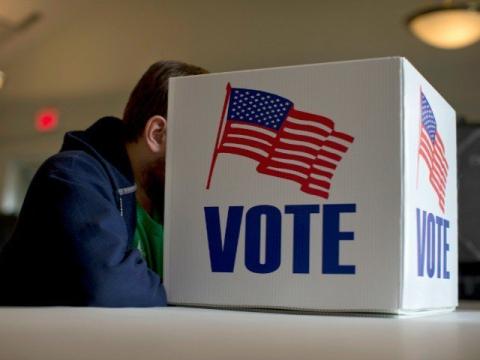Voters have expressed their desire to see systemic reform to how we elect our public officials. When asked what specific reforms they want in a recent poll, many said they would like to see a proportional representation system -- which would mean a complete election overhaul.
What would proportional representation mean?
Proportional representation is exactly how it sounds. An electoral district is not represented by a single seat, but multiple seats that are proportionally allocated among candidates running based on who reaches a predetermined vote threshold.
A congressional district, for example, could have 3,4, or even 5 seats depending on how the system is designed. If there are three seats, the candidates who get at least a quarter of the vote are elected to a seat.
Another way to think of the vote threshold needed is a “quota.” If two people are running for a single seat, the quota needed to win is 50% plus one. If three people are running to fill two seats, the quota is 33% plus one.
The math behind a vote threshold/quota is simple. Take the number of seats, add 1, and then divide 100 (the percent of the total vote) by that number.
Candidates are selected in a single election that uses a preferential voting method like ranked choice voting. The process is easy for voters. Under a proportional ranked choice voting system, they rank the candidates on the ballot in order of preference.
That’s it. That's all the voter needs to worry about.
Vote tabulation works similar to the increasingly more common method of single-winner ranked choice voting used in dozens of cities, as well as a couple of states (Maine and Alaska). If no candidates reach the vote threshold needed to win a seat, the last place candidate is eliminated and their voters’ second choices are applied to the results.
The process continues with subsequent rounds of runoff as needed until enough candidates reach the vote threshold to fill all the seats in the district.
Proportional ranked choice voting differs from the standard ranked choice voting method in that if a candidate has a surplus of votes, meaning they exceed the threshold, the excess votes are counted for the voters’ next choice. Advocates say this is to ensure no vote is wasted.
Here is how proportional representation works in the Victoria, Australia:
Proportional representation can be used at all levels of government, from city council to state legislature to Congress, and would mean that elections are not determined solely by the majority or plurality of voters who turnout in a given election (which can change from cycle to cycle), but give all voters who participate a chance at representation.
Proportional Representation Is Already Being Used in the US
Proportional ranked choice voting (RCV) is currently used in 6 local jurisdictions in the US. Albany, California; Palm Desert; California; and Cambridge, Massachusetts use proportional RCV for city council elections. Albany and Palm Desert used it for the first time in 2022.
Arden, Delaware has used proportional RCV for town council elections since the early twentieth century. Minneapolis, Minnesota uses it for two municipal boards.
Possibly the most interesting case of its use is in Eastpointe, Michigan. Proportional RCV was adopted in 2019 and 2021 to resolve a Voting Rights Act lawsuit. The US Department of Justice recommended proportional RCV as a remedy to end racial discrimination in city elections.
Filmmaker Grace McNally dives deep into the 2017 DOJ lawsuit that brought about this change, the inherent discrimination that can be found in at-large electoral systems, and why proportional RCV was offered as the solution the city needed. Watch her documentary, Eastpointe, here.
Six cities currently use it, but more cities will soon follow, including Portland, Oregon. Nearly 60% of Portland voters said “Yes” to Measure 26-228 in November 2022, which expands the number of city council seats to 12, with 3 seats to a district, and implements ranked choice voting for city elections.
The Future of Proportional Elections
Much of the growth in the alternative nothing method space has been single-winner reform. RCV has been adopted in several jurisdictions, representing millions of voters, and is gaining support from voters, elected officials, and election administrators across the political spectrum.
Groups like FairVote, the nation’s preeminent advocate for RCV and proportional representation, would like to expand on the success of this movement to include proportional representation for Congress.
“We’re on a 10-year plan,” said Deb Otis, Director of Research and Policy at FairVote. “We think we can get there, and passing a lot of these single-winner ranked choice implementations is one of the steps to help us get there."
Looking at a map of cities that currently use proportional RCV, Otis explained that where proportional RCV is at now is where single-winner RCV was about a decade ago – with only a handful of cities using it back then.
Today, 62 US jurisdictions have adopted and/or are using single-winner RCV. This includes areas with heavy Republican influence and heavy Democratic influence. This includes two states, Alaska and Maine.
And, state parties (both Republican and Democratic) have used it to determine their leadership and nominees in places like Utah and Virginia.
“As folks started using it, seeing how well it worked in practice, it started expanding really quickly,” said Otis. “We’ve had exponential growth over the last decade. Proportional representation, now, is about ready to hit that same exponential growth.”
She added that voters should especially look to Portland and how voters respond to the new voting system as they start using it.
FairVote supports a bill that has been introduced in Congress called the Fair Representation Act. The bill would establish multi-member congressional districts, implement ranked choice voting for congressional elections, and create new requirements for congressional redistricting aimed at ending gerrymandering.
Read more about the bill here.
